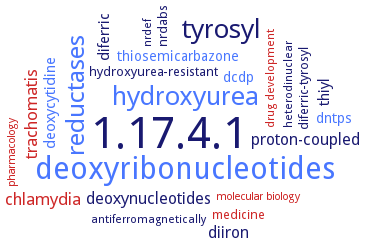1.17.4.1: ribonucleoside-diphosphate reductase
This is an abbreviated version!
For detailed information about ribonucleoside-diphosphate reductase, go to the full flat file.

Word Map on EC 1.17.4.1 
-
1.17.4.1
-
deoxyribonucleotides
-
hydroxyurea
-
tyrosyl
-
reductases
-
chlamydia
-
trachomatis
-
deoxynucleotides
-
proton-coupled
-
diiron
-
deoxycytidine
-
diferric
-
thiyl
-
dntps
-
dcdp
-
thiosemicarbazone
-
diferric-tyrosyl
-
nrdabs
-
hydroxyurea-resistant
-
medicine
-
nrdef
-
heterodinuclear
-
drug development
-
antiferromagnetically
-
pharmacology
-
molecular biology
- 1.17.4.1
- deoxyribonucleotides
- hydroxyurea
-
tyrosyl
- reductases
- chlamydia
- trachomatis
-
deoxynucleotides
-
proton-coupled
-
diiron
- deoxycytidine
-
diferric
-
thiyl
- dntps
- dcdp
- thiosemicarbazone
-
diferric-tyrosyl
-
nrdabs
-
hydroxyurea-resistant
- medicine
-
nrdef
-
heterodinuclear
- drug development
-
antiferromagnetically
- pharmacology
- molecular biology
Reaction
Synonyms
2'-deoxyribonucleoside-diphosphate:oxidized-thioredoxin 2'-oxidoreductase, ADP reductase, CDP reductase, class I ribonucleotide reductase, class I ribonulceotide reductase, class I RNR, class I RR, class Ia ribonucleotide reductase, class Ia RNR, class Ia RR, class Ib ribonucleotide reductase, class Ib RNR, class Ic ribonucleotide reductase, class II RNR, manganese-ribonucleotide reductase, Mn-RNR, More, mRR, NrdA, NrdB, NrdE, NrdF, nucleoside diphosphate reductase, p53-inducible ribonucleotide reductase, R2F, reductase, ribonucleoside diphosphate, ribonucleoside 5'-diphosphate reductase, ribonucleoside diphosphate reductase, ribonucleoside-diphosphate reductase subunit M2 B, ribonucleotide diphosphate reductase, ribonucleotide reductase, RIR1, RIR2, RNR, RNR1 rRibonucleoside-diphosphate reductase large chain 1, RNR2, UDP reductase


 results (
results ( results (
results ( top
top





